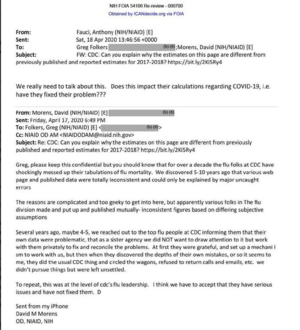Flu
(disease) | |
|---|---|
| Interest of | • Robert Malone • Don Craig Wiley |
Influenza, commonly known as the flu - is a mix of fever, runny nose, sore throat, muscle pain, headache, coughing, and fatigue.
Contents
Official narrative

An infectious disease caused by influenza viruses. Annual vaccination can help to provide protection against influenza.
In a typical year, five to 15 percent of the population contracts influenza. There are 3 to 5 million severe cases annually, with up to 650,000 respiratory-related deaths globally each year.[2]
Problems with official narrative
A 2010 Cochrane Collaboration metastudy found that there is 'no effect' of influenza vaccination on hospitalization, and that there is "no evidence that vaccines prevent viral transmission or complications."[3]
Pandemics and sunspots

In 1978 two researchers (Hope-Simpson) pointed out a remarkable coincidence between peaks in the sunspot curve, when solar activity is at a maximum, and the occurrence of influenza pandemics associated with antigenic shifts of the virus, leading to the suspicion that solar activity and influenza activity may have a causal link. The two phenomena, which have irregular periods (with an average period of 11 years), appear to have kept in step over some 17 cycles, at least since 1761. "Past experience has shown that false correlations of phenomena with the sunspot cycle may look good over a few cycles but go seriously adrift after an appreciable number of cycles. This does not happen for the postulated sunspot-flu connection."[4]
F. Hoyle N.C. Wick Ramasinghe hypothesized that "electrical fields associated with intense solar winds can rapidly drive charged particles of the size of viruses down through the exposed upper atmosphere into the shelter of the lower atmosphere, the charging of such particles being due to the photoelectric effect."[4]
References
- ↑ https://icandecide.org/wp-content/uploads/2024/08/IR0279-July-2024-Production.pdf
- ↑ https://www.ncbi.nlm.nih.gov/pmc/articles/PMC6149781
- ↑ https://www.jeremyrhammond.com/2018/10/19/its-flu-shot-propaganda-season-beware-the-big-lies-about-the-vaccine/?feed_id=25
- ↑ a b https://www.nature.com/articles/343304b0.pdf